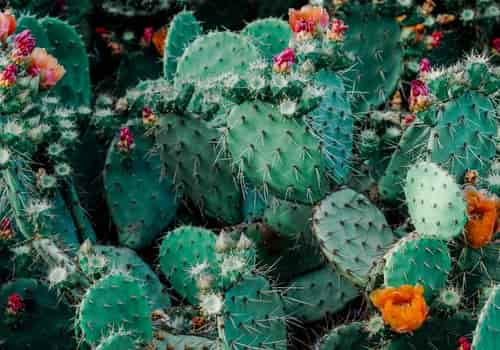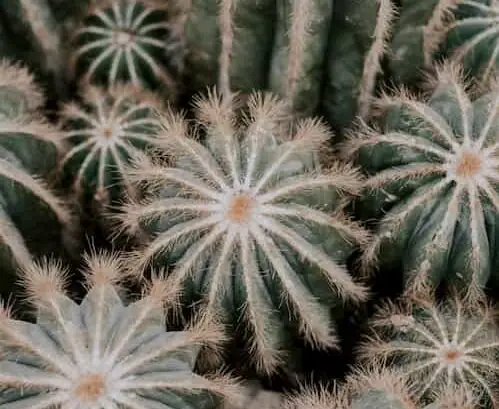Succulents are one of the best plants you can grow in Arizona as this plant group contains a variety of succulents you can grow depending on your weather conditions. So…
Do succulents grow in Arizona? Succulents grow great under conditions of bright sunlight and warmer temperatures. The climate of Arizona suits the growth of succulents perfectly & the fact that Arizona does not experience freezing temperatures makes it one of the best places to grow succulents, both indoors and outdoors.
Table of Contents
Can Succulents live Outside in Arizona?
Succulents can live & thrive well outdoors in Arizona provided you grow them under some kind of shade. The temperature in the Summer months in the majority of the places here can go above 90°F (32°C) and during this period even the succulents that love moderate to high light, can get damaged due to the scorching heat.
The excess heat can leave sunburns and can stress out the plant completely. Having a small shade in the garden is important for this purpose. Succulents are highly adaptive plants and they will do just fine if they indirect light for 4 to 6 hours a day. So in case, your place gets around 100°F it’s a great idea to grow them under some kind of shed and not under full sun.
Top 5 Succulents you can grow in Arizona
Ponytail Palm
Scientific Name: Beaucarnea recurvata
Other names: Elephant foot tree
Country of Origin: Mexico
Personally, this is one of my favorite succulents! It’s incredibly adaptive and has a stunning appearance that is bound to turn heads!
The succulent has got a bulb-like stem base and the stem is sleek & sturdy. The leaves are ribbon-like thin and curly. The leaves are what give the plant its stunning appearance & they give off a ponytail kind of a look, hence giving it the name, ponytail palm.
- On top of this, Ponytail Palm is quite forgiving in nature and can be grown both indoors and outdoors.
- The Plantbulb-like stem of the plant is well suited to store water for long periods of time & as long as you water them once every few days or a week( depending on the soil dryness) & have them planted on a cactus mix soil, they will take care of themselves pretty well.
- It loves bright sunlight but can equally grow under conditions of partial shade.
Prickly Pear
Other names: Nopal cactus or Paddle cactus

They are popularly grown as ornamental plants mainly in the garden. Even though they can be slow-growing, if they get sufficient bright sun, they can produce beautiful flowers with vibrant colors.
Some varieties of Prickly pears can contain bristles that can cause skin allergic reactions. So you should take caution handling them. Other varieties can be totally spineless and grow in clusters which gives them their unique appearance.
In case you have children in the house it’s best to opt for the spineless varieties. If you are growing the types with spine then use gloves, full sleeve dresses, and suitable caution during handling.
- They grow actively during the summer and after the fall, the vibrancy of the green pads can start decreasing and it can end up with a wilted appearance in the colder months. However, as soon as Spring approaches it will go back to its former vibrancy.
This succulent thrives greatly in zones 9-11 and prefers a warmer climate. It cannot survive a freeze so it must be grown outdoors only if the colder months of the place are sufficiently warm. So if you are worried about the succulent during winter, you can either bring them inside.
(Tip: If your place gets a bit chilly then grow your succulents in containers that can be moved around pretty easily. Go for hardy varieties and in case you are growing non-hardy ones, grow them in containers of suitable quality as Prickly Pear can be quite heavy).
- Loves full sun and one of the best succulents you can grow completely outdoors. Another great thing is the succulent is quite easy to propagate from stem cuttings. You can also grow it from seeds as prickly pear produces colorful fruits during the summer.
Prickly Pear is a hardcore xerophyte that must be watered with caution. It can store water for months and is highly drought resistant. Generally, in the summer months, you can water it once every 2 to 3 weeks and once a month after the fall.
In case it rains, then dont go ahead with your watering schedule and the key thing is to only water the succulent when the soil feels properly dry (source).
Its various types can include purple prickly pear or Beavertail Prickly pear.
Ball Cactus
Scientific Name: Parodia magnifica
Other names: the silver ball cactus
Country of Origin: Central America
This again is another of my favorites. In case you are looking to enhance the aesthetic of your balcony or garden, this succulent is well suited for that. If you can grow them in numbers in the garden, it will look incredible from a distance.
- However, they do best when kept under partial shade. So in case you wanna grow them outdoors, keep them under some kind of shade so that it can get enough indirect light.
- Ball cactuses produce flowers of various colors that can range from yellow, pink, red as per the species type. The ball-like structure gives them a visually stunning look that changes the feel of a place totally.
You can find that Ball cactuses need a little more frequent watering than other cactuses. It sucks water faster from the soil however just like all cactuses be extremely cautious to not overwater the plant. Cactuses can tolerate underwatering but not overwatering.
If possible bring them indoors during the winter for better flowering and water them as per need (source).
Senecio serpens
Other names: Blue Chalk Sticks
Country of Origin: South Africa
Blue Chalk Sticks loves full sun and needs the bright sun to gain their bluish-green color. In case you wanna grow it indoors, make sure to place it near a south-facing window.
- The Bue Chalk sticks have got finger-like projections in clusters which makes them an attractive garden plant.
- It’s well suited to be grown outdoors in USDA zones of 100 and 11. They can tolerate moderate cooler temperatures but not freezing. So it’s best to grow them in containers and bring them inside during winter.
Once mature their watering needs are also less. In growing conditions, they can soak up the soil moisture in a week during hotter months.
- It’s an ideal plant to grow along the lining or border. As it has a rare color shade it will bring a great contrast among your plant varieties.
Agaves
Other names: Century Plants
Agaves are slow growers however they produce flashy leaves and can grow up to a height of 10 feet in matured conditions.
They love full sun & flowers only once in their life in most cases. In case you wanna use it for lining a particular place, pool, road, wall, or wanna use it as a contrast then this is your go-to plant. Also, Agaves are extremely low maintenance and their fleshy leaves allow them to store water for weeks.
- Just provide them with sufficient bright sun(it loves full sun) and plant them in well-draining soil, they will do just fine hereon. It doesn’t tolerate extreme frost so it’s well suited for the majority of the Arizona climate.
